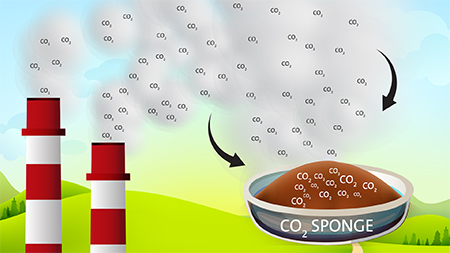 The new sponge-like material could ease the transition to hydrogen fuel (graphic courtesy of the American Chemical Society)
The new sponge-like material could ease the transition to hydrogen fuel (graphic courtesy of the American Chemical Society)
A sponge-like plastic, developed at the University of Liverpool, which soaks up the greenhouse gas carbon dioxide (CO2), might ease the transition from polluting fossil fuels and toward new energy sources.
The material is designed to be integrated into power plant smokestacks in the future as part of an emerging technology called an integrated gasification combined cycle (IGCC), which can convert fossil fuels into hydrogen gas. Hydrogen holds great promise for use in fuel-cell cars and electricity generation because it produces almost no pollution.
Adsorption
Chemist, Professor Andy Cooper, led the development of the material which is a relative of the plastics used in food containers. It works through a process of adsorption.
Professor Cooper said: “The key point is that this new plastic polymer is stable, cheap, and it adsorbs CO2 extremely well. It’s geared toward function in a real-world environment.
“In a future landscape where fuel-cell technology is used, this adsorbent could work towards zero-emission technology.”
IGCC is a bridging technology that is intended to jump-start the hydrogen economy, or the transition to hydrogen fuel, while still using the existing fossil-fuel infrastructure. But the IGCC process yields a mixture of hydrogen and CO2 gas, which must be separated.
“When the pressure drops, the adsorbent deflates and releases the CO2, which can be collected for storage or, possibly, converted into useful carbon compounds.”
The material is a brown, sand-like powder made by linking together many carbon-based molecules into a network. It was inspired by polystyrene, a plastic used in styrofoam and other packaging material. Polystyrene can adsorb small amounts of CO2 by the same swelling action.
One advantage of using such polymers is that they tend to be stable. The material can even withstand being boiled in acid, proving it should tolerate the harsh conditions in power plants where CO2 adsorbents are needed.
Another advantage of the new adsorbent is its ability to adsorb CO2 without also taking on water vapour, which can clog up other materials and make them less effective. Its low cost also makes the sponge polymer attractive.
Inexpensive and highly reusable
“Compared to many other adsorbents, they’re relatively cheap,” Professor Cooper said. “Mostly because the carbon molecules used to make them are inexpensive. In principle, they’re also highly reusable and have long lifetimes because they’re robust.”
The research was presented at the 248th National Meeting and Exposition of the American Chemical Society and was funded by the Engineering and Physical Sciences Research Council and E.ON Energy. The project also involved collaborators at the University of Nottingham and Imperial College London.
Find out more about studying chemistry on the University’s study pages, or follow the School of Physical Sciences on Twitter.